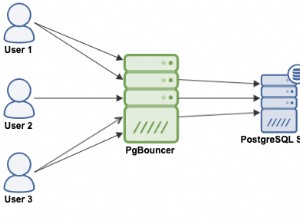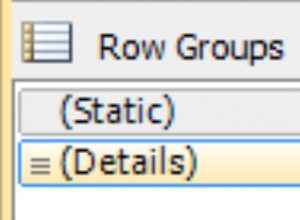Hier ist eine Lösung, die auf verschachtelten Unterabfragen basiert. Zuerst habe ich ein paar Zeilen hinzugefügt, um ein paar weitere Fälle zu erfassen. Transaktion 10 sollte beispielsweise nicht durch Transaktion 12 abgebrochen werden, da Transaktion 11 dazwischen kommt.
> select * from transactions order by date_time;
+----+---------+------+---------------------+--------+
| id | account | type | date_time | amount |
+----+---------+------+---------------------+--------+
| 1 | 1 | R | 2012-01-01 10:01:00 | 1000 |
| 2 | 3 | R | 2012-01-02 12:53:10 | 1500 |
| 3 | 3 | A | 2012-01-03 13:10:01 | -1500 |
| 4 | 2 | R | 2012-01-03 17:56:00 | 2000 |
| 5 | 1 | R | 2012-01-04 12:30:01 | 1000 |
| 6 | 2 | A | 2012-01-04 13:23:01 | -2000 |
| 7 | 3 | R | 2012-01-04 15:13:10 | 3000 |
| 8 | 3 | R | 2012-01-05 12:12:00 | 1250 |
| 9 | 3 | A | 2012-01-06 17:24:01 | -1250 |
| 10 | 3 | R | 2012-01-07 00:00:00 | 1250 |
| 11 | 3 | R | 2012-01-07 05:00:00 | 4000 |
| 12 | 3 | A | 2012-01-08 00:00:00 | -1250 |
| 14 | 2 | R | 2012-01-09 00:00:00 | 2000 |
| 13 | 3 | A | 2012-01-10 00:00:00 | -1500 |
| 15 | 2 | A | 2012-01-11 04:00:00 | -2000 |
| 16 | 2 | R | 2012-01-12 00:00:00 | 5000 |
+----+---------+------+---------------------+--------+
16 rows in set (0.00 sec)
Erstellen Sie zunächst eine Abfrage, um für jede Transaktion „das Datum der letzten Transaktion vor dieser im selben Konto“ abzurufen:
SELECT t2.*,
MAX(t1.date_time) AS prev_date
FROM transactions t1
JOIN transactions t2
ON (t1.account = t2.account
AND t2.date_time > t1.date_time)
GROUP BY t2.account,t2.date_time
ORDER BY t2.date_time;
+----+---------+------+---------------------+--------+---------------------+
| id | account | type | date_time | amount | prev_date |
+----+---------+------+---------------------+--------+---------------------+
| 3 | 3 | A | 2012-01-03 13:10:01 | -1500 | 2012-01-02 12:53:10 |
| 5 | 1 | R | 2012-01-04 12:30:01 | 1000 | 2012-01-01 10:01:00 |
| 6 | 2 | A | 2012-01-04 13:23:01 | -2000 | 2012-01-03 17:56:00 |
| 7 | 3 | R | 2012-01-04 15:13:10 | 3000 | 2012-01-03 13:10:01 |
| 8 | 3 | R | 2012-01-05 12:12:00 | 1250 | 2012-01-04 15:13:10 |
| 9 | 3 | A | 2012-01-06 17:24:01 | -1250 | 2012-01-05 12:12:00 |
| 10 | 3 | R | 2012-01-07 00:00:00 | 1250 | 2012-01-06 17:24:01 |
| 11 | 3 | R | 2012-01-07 05:00:00 | 4000 | 2012-01-07 00:00:00 |
| 12 | 3 | A | 2012-01-08 00:00:00 | -1250 | 2012-01-07 05:00:00 |
| 14 | 2 | R | 2012-01-09 00:00:00 | 2000 | 2012-01-04 13:23:01 |
| 13 | 3 | A | 2012-01-10 00:00:00 | -1500 | 2012-01-08 00:00:00 |
| 15 | 2 | A | 2012-01-11 04:00:00 | -2000 | 2012-01-09 00:00:00 |
| 16 | 2 | R | 2012-01-12 00:00:00 | 5000 | 2012-01-11 04:00:00 |
+----+---------+------+---------------------+--------+---------------------+
13 rows in set (0.00 sec)
Verwenden Sie dies als Unterabfrage, um jede Transaktion und ihren Vorgänger in derselben Zeile abzurufen. Verwenden Sie einige Filter, um die Transaktionen herauszuziehen, an denen wir interessiert sind – nämlich „A“-Transaktionen, deren Vorgänger „R“-Transaktionen sind, die sie genau aufheben –
SELECT
t3.*,transactions.*
FROM
transactions
JOIN
(SELECT t2.*,
MAX(t1.date_time) AS prev_date
FROM transactions t1
JOIN transactions t2
ON (t1.account = t2.account
AND t2.date_time > t1.date_time)
GROUP BY t2.account,t2.date_time) t3
ON t3.account = transactions.account
AND t3.prev_date = transactions.date_time
AND t3.type='A'
AND transactions.type='R'
AND t3.amount + transactions.amount = 0
ORDER BY t3.date_time;
+----+---------+------+---------------------+--------+---------------------+----+---------+------+---------------------+--------+
| id | account | type | date_time | amount | prev_date | id | account | type | date_time | amount |
+----+---------+------+---------------------+--------+---------------------+----+---------+------+---------------------+--------+
| 3 | 3 | A | 2012-01-03 13:10:01 | -1500 | 2012-01-02 12:53:10 | 2 | 3 | R | 2012-01-02 12:53:10 | 1500 |
| 6 | 2 | A | 2012-01-04 13:23:01 | -2000 | 2012-01-03 17:56:00 | 4 | 2 | R | 2012-01-03 17:56:00 | 2000 |
| 9 | 3 | A | 2012-01-06 17:24:01 | -1250 | 2012-01-05 12:12:00 | 8 | 3 | R | 2012-01-05 12:12:00 | 1250 |
| 15 | 2 | A | 2012-01-11 04:00:00 | -2000 | 2012-01-09 00:00:00 | 14 | 2 | R | 2012-01-09 00:00:00 | 2000 |
+----+---------+------+---------------------+--------+---------------------+----+---------+------+---------------------+--------+
4 rows in set (0.00 sec)
Aus dem obigen Ergebnis geht hervor, dass wir es fast geschafft haben – wir haben die unerwünschten Transaktionen identifiziert. Verwenden von LEFT JOIN wir können diese aus dem gesamten Transaktionssatz herausfiltern:
SELECT
transactions.*
FROM
transactions
LEFT JOIN
(SELECT
transactions.id
FROM
transactions
JOIN
(SELECT t2.*,
MAX(t1.date_time) AS prev_date
FROM transactions t1
JOIN transactions t2
ON (t1.account = t2.account
AND t2.date_time > t1.date_time)
GROUP BY t2.account,t2.date_time) t3
ON t3.account = transactions.account
AND t3.prev_date = transactions.date_time
AND t3.type='A'
AND transactions.type='R'
AND t3.amount + transactions.amount = 0) t4
USING(id)
WHERE t4.id IS NULL
AND transactions.type = 'R'
ORDER BY transactions.date_time;
+----+---------+------+---------------------+--------+
| id | account | type | date_time | amount |
+----+---------+------+---------------------+--------+
| 1 | 1 | R | 2012-01-01 10:01:00 | 1000 |
| 5 | 1 | R | 2012-01-04 12:30:01 | 1000 |
| 7 | 3 | R | 2012-01-04 15:13:10 | 3000 |
| 10 | 3 | R | 2012-01-07 00:00:00 | 1250 |
| 11 | 3 | R | 2012-01-07 05:00:00 | 4000 |
| 16 | 2 | R | 2012-01-12 00:00:00 | 5000 |
+----+---------+------+---------------------+--------+




